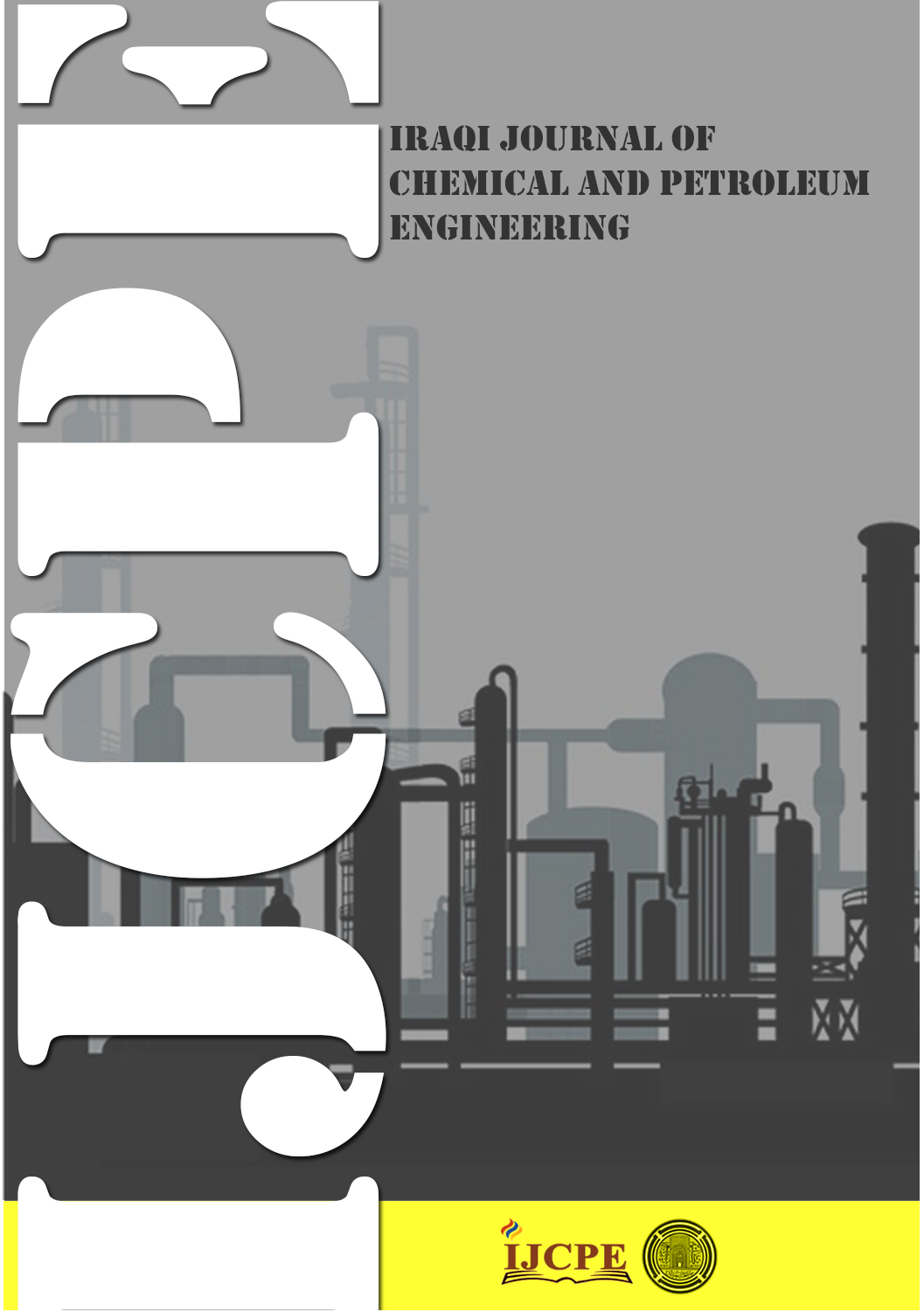Estimation of static modulus of carbonate formation for Rumaila oil field
DOI:
https://doi.org/10.31699/IJCPE.2025.2.8Keywords:
Static Modulus; Elastic properties; well logging; Carbonate FormationAbstract
Elastic parameters are essential for understanding the behavior of materials under stress, including their tendency for deformation and failure. Elastic modulus is a key parameter, which can be determined using static and dynamic methods. Dynamic methods involve analyzing properties from well logging such as density and wave velocity (compressional and shear waves), while static techniques quantify properties in a laboratory setting. While static techniques are the most accurate, they are also expensive and time consuming. However, there are correlations available to estimate static modules from dynamic modules, although many are specific to certain formations and not applicable to different rock types. In this paper, a new correlation was developed for predicting the static Young's modulus for carbonate formations in the Rumaila Oil Field based on dynamic modulus. Data from 4803 points in an 8.5 in hole size section between 1980 m and 2711 m depth were collected. The results showed that the new correlation accurately predicted the static Young's modulus of carbonate formation, a correlation coefficient (RSQ) of 97%, and an average absolute error of 8.15%. The new correlation provides a continuous profile of static Young's modulus with depth and ultimately leads to reduce the cost of estimating elastic properties in carbonate formations in the Rumaila Oil Field.
Received on 07/06/2024
Received in Revised Form on 27/08/2024
Accepted on 02/09/2024
Published on 30/06/2025
References
[1] D. S. Mahdi and A. A. A. A Alrazzaq, "Rock Mechanical Properties: A Review of Experimental Tests and Prediction Approaches," Iraqi Journal of Oil Gas Research, vol. 3, no. 1, pp. 106-115, 2023. https://doi.org/10.55699/ijogr.2023.0301.1044
[2] K. H. Hassan and H. A. A. Hussien, "Estimation of rock strength from sonic log for Buzurgan oil field: A Comparison study," Iraqi Journal of Chemical and Petroleum Engineering, vol. 20, no. 1, pp. 49-52, 2019. https://doi.org/10.31699/IJCPE.2019.1.7
[3] R. K. AbdulMajeed and A. A. Alhaleem, "Estimation of shear wave velocity from wireline logs data for Amara Oilfield, Mishrif Formation, Southern Iraq," Iraqi Geological Journal, pp. 36-47, 2020. https://doi.org/10.46717/igj.53.1a.R3.2020.01.30
[4] U. Alameedy, A. A. Alhaleem, A. Isah, A. Al-Yaseri, A. El-Husseiny, and M. Mahmoud, "Predicting dynamic shear wave slowness from well logs using machine learning methods in the Mishrif Reservoir, Iraq," Journal of Applied Geophysics, vol. 205, p. 104760, 2022. https://doi.org/10.1016/j.jappgeo.2022.104760
[5] U. Alameedy, A. Fatah, A. K. Abbas, and A. Al-Yaseri, "Matrix acidizing in carbonate rocks and the impact on geomechanical properties: A review," Fuel, vol. 349, p. 128586, 2023. https://doi.org/10.1016/j.fuel.2023.128586
[6] M. A. Issa and A. A. A. A. Alrazzaq, "Estimation of the In-Situ Stresses for One Iraqi Oil Field: A Case Study," Eurasian Journal of Engineering and Technology, vol. 9, pp. 126-133, 2022.
[7] H. Ledbetter and E. A, "Dynamic vs. static Young's moduli: a case study," Materials Science, vol. 165, no. 1, pp. L9-L10, 1993. https://doi.org/10.1016/0921-5093(93)90634-Q
[8] A. Hammam and M. Eliwa, "Comparison between results of dynamic & static moduli of soil determined by different methods," HBRC Journal, vol. 9, no. 2, pp. 144-149, 2013. https://doi.org/10.1016/j.hbrcj.2013.05.002
[9] M. A. Issa and F. A. Hadi, "Estimation of mechanical rock properties from laboratory and wireline measurements for sandstone reservoirs," Iraqi Geological Journal, pp. 125-137, 2021. https://doi.org/10.46717/igj.54.2D.10Ms-2021-10-29
[10] M. A. Issa, M. A. Issa, and A. A. A. A. Alrazzaq, "Developing a Geomechanical Model to Mitigate the Risks of Wellbore Instability in an Iraqi Oilfield," Indian Geotechnical Journal, pp. 1-14, 2023. https://doi.org/10.1007/s40098-023-00726-3
[11] L. Hilbert, T. Hwong, N. Cook, K. Nihei, and L. Myer, "Effects of strain amplitude on the static and dynamic nonlinear deformation of Berea sandstone," in 1st North American Rock Mechanics Symposium, 1994: OnePetro.
[12] N. F. Hussain and F. H. M. Al Mahdawi, "Prediction of fracture pressure gradient in Halfaya oilfield," Iraqi Journal of Chemical and Petroleum Engineering, vol. 20, no. 1, pp. 1-7, 2019. https://doi.org/10.31699/IJCPE.2019.1.1
[13] K. H. A. H. Mnati, Hassan "Prediction of penetration rate and cost with artificial neural network for alhafaya oil field," Iraqi Journal of Chemical and Petroleum Engineering, vol. 19, no. 4, pp. 21-27, 2018. https://doi.org/10.31699/IJCPE.2018.4.3
[14] V. S. Vutukuri, R. D. Lama, and S. Saluja, "Handbook on mechanical properties of rocks," 1974.
[15] R. Plumb, "Influence of composition and texture on the failure properties of clastic rocks," in Rock mechanics in petroleum engineering, 1994: OnePetro. https://doi.org/10.2118/28022-MS
[16] W. Zisman, "Comparison of the statically and seismologically determined elastic constants of rocks," Proceedings of the National Academy of Sciences, vol. 19, no. 7, pp. 680-686, 1933. https://doi.org/10.1073/pnas.19.7.680
[17] D. Howarth, "Apparatus to determine static and dynamic elastic moduli," Rock Mechanics and Rock Engineering, vol. 17, no. 4, pp. 255-264, 1984. https://doi.org/10.1007/BF01032338
[18] Z. Wang and A. Nur, "Dynamic versus static elastic properties of reservoir rocks," Seismic acoustic velocities in reservoir rocks, vol. 3, pp. 531-539, 2000.
[19] J. M. Ide, "Comparison of statically and dynamically determined Young's modulus of rocks," Proceedings of the National Academy of Sciences, vol. 22, no. 2, pp. 81-92, 1936. https://doi.org/10.1073/pnas.22.2.81
[20] V. Tuman and R. Alm, "Dynamic and Static Elastic Properties," 1963.
[21] M. King, "Static and dynamic elastic moduli of rocks under pressure," in ARMA US Rock Mechanics/Geomechanics Symposium, 1969, pp. ARMA-69-0329: ARMA.
[22] W. Lin and F. Heuze, "In-situ dynamic moduli of Mesaverde rocks, compared to static and dynamic laboratory moduli," in ARMA US Rock Mechanics/Geomechanics Symposium, 1986, pp. ARMA-86-0682: ARMA.
[23] C. Rabe and J. Odreman, "Dynamic and static rock mechanical properties of heavy oil sandstones," in ISRM International Symposium-Asian Rock Mechanics Symposium, 2012, pp. ISRM-ARMS7-2012-040: ISRM.
[24] R. Holt, O.-M. Nes, J. Stenebraten, and E. Fjær, "Static vs. dynamic behavior of shale," in ARMA US Rock Mechanics/Geomechanics Symposium, 2012, pp. ARMA-2012-542: ARMA.
[25] V. Brotons, R. Tomás, S. Ivorra, A. Grediaga, "Relationship between static and dynamic elastic modulus of calcarenite heated at different temperatures: the San Julián’s stone," Bulletin of Engineering Geology and the Environment, vol. 73, pp. 791-799, 2014. https://doi.org/10.1007/s10064-014-0583-y
[26] W. Canady, "A method for full-range Young's modulus correction," in North American unconventional gas conference and exhibition, 2011: OnePetro. https://doi.org/10.2118/143604-MS
[27] R. E. Goodman, Introduction to rock mechanics. Wiley New York, 1989.
[28] E. Eissa and A. Kazi, "Relation between static and dynamic Young's moduli of rocks," International Journal of Rock Mechanics and Mining, vol. 25, no. 6, 1988. https://doi.org/10.1016/0148-9062(88)90987-4
[29] L. L. Lacy, "Dynamic rock mechanics testing for optimized fracture designs," in SPE annual technical conference and exhibition, 1997: OnePetro. https://doi.org/10.2118/38716-MS
[30] A. Nur and Z. Wang, Seismic and acoustic velocities in reservoir rocks (no. 10). Society of Exploration Geophysicists, 1989.
[31] A. R. Najibi, M. Ghafoori, G. R. Lashkaripour, M. R. Asef, "Empirical relations between strength and static and dynamic elastic properties of Asmari and Sarvak limestones, two main oil reservoirs in Iran," Journal of Petroleum Science and Engineering, vol. 126, pp. 78-82, 2015. https://doi.org/10.1016/j.petrol.2014.12.010
Downloads
Published
Issue
Section
License
Copyright (c) 2025 The Author(s). Published by College of Engineering, University of Baghdad.

This work is licensed under a Creative Commons Attribution 4.0 International License.













